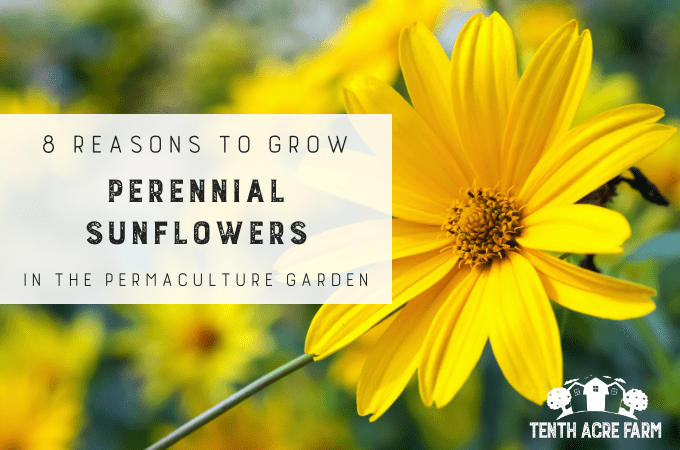Perennial sunflowers are beautiful and multifunctional. Learn 8 reasons to grow native sunflowers in your permaculture garden as an ecological powerhouse.

This page may contain affiliate links. Please read my disclosure for more info.
Sunflowers (Helianthus) have a long history as a useful and edible plant for Native Americans. In fact, there are 150 species of sunflower, most of which are native to North America. You may already be familiar with annual sunflowers ( H. annuus), which are quite delightful in the garden and provide delicious edible seeds.
Perennial sunflowers are also quite cheery and useful, with many varieties to choose from, spread across most growing zones with a variety of heights and bloom sizes.
Regardless of the variety of perennial sunflowers you choose, the blooms are a lovely addition to the edible landscape. They also increase biodiversity and are super useful in the permaculture garden.
How I Met Perennial Sunflowers
I was first introduced to perennial sunflowers years ago when Mr. TAF and I were planning our wedding.
We found Karen and Ed of Wildey Flower Farm at the farmers’ market, and fell in love with their gorgeous bouquets and fun personalities. So we asked them to supply wildflower arrangements for our wedding.
They scratched their heads and said that cut flower requests for wildflowers weren’t typical for late September. After all, most things are finished blooming by that date!
Still, they invited us out to the farm, where we took a ride through the farm fields, pointing out the different things blooming. The thing is, most wildflowers are so common that they don’t catch the eye of most brides.
Karen and Ed were surprised by our enthusiasm for the wildflowers, but they took on the challenge. In the end, we were thrilled with their artful combinations of goldenrod, thistle, asters, and more, with the perennial sunflowers taking center stage in the wedding bouquets.

Here’s me with my wildflower bouquet starring perennial sunflowers.
Multifunctional Plants in Permaculture
I didn’t realize how useful perennial sunflowers were until after the wedding, when I started to learn more about permaculture. Through permaculture, we seek to design food-growing systems that also regenerate ecology.
By using multifunctional plants, we can create a web of connectedness throughout the garden, which can reduce work as well as reduce the need to import materials.
(Curious about permaculture? Read: What is Permaculture? Designing a Resilient Garden).
Excited about the multifunctional aspects of perennial sunflowers, I planted Maximilian sunflower (Helianthus maximiliani) on the edge of our community garden. While we got some blooms, it didn’t form a thick planting like I had hoped.
Unfortunately, they don’t thrive in the shade.

Maximilian sunflowers at the community garden
Growing Habits of Perennial Sunflowers
Where you grow perennial sunflowers takes some planning, since they can grow from 3-8 feet tall in ideal conditions. Their rhizomatous roots can spread rapidly. Therefore, plant them where they can spread out, or where you can mow a perimeter around them for containment.
Most perennial sunflowers grow in full sun in zones 3-9, and flower in the late summer through fall. They naturally grow in sunny prairies, quite comfortably among grasses, and are very drought tolerant.
You may also find them growing in disturbed areas, such as along roadsides. Just look for their yellow, daisy-like blooms.
Grow them in moist but not waterlogged soil that is well-drained. If the soil is too rich and moist, the plants may grow weak and spindly and flop over.
Want to grow fruits, vegetables, and herbs in your front yard landscape without sacrificing curb appeal? Check out my mini guide, The Permaculture Inspired Edible Landscape.
8 Reasons to Grow Perennial Sunflowers in the Permaculture Garden
Over the years, I’ve fallen in love with how useful this plant is. It’s a great example of stacking functions.
Native Americans used the plants for food, oil, dye, and thread, according to the USDA Natural Resources Conservation Service. Reportedly, pioneers planted them near their homes to repel mosquitoes.
The following are some of the reasons why perennial sunflowers might be the right plant for your landscape or garden.
#1: Perennial sunflowers are edible.
Perennial sunflowers don’t have the big seeds that annual sunflowers produce. However, the small seeds—harvested in late October and November—were eaten by Native Americans as a snack and sprinkled on salads and other foods.
Try saving the seeds to make sunflower oil (though they aren’t as productive as black oil sunflower seeds).
Jerusalem artichokes, also called sunchokes (Helianthus tuberosus), are perhaps the most popular of perennial sunflowers in this department. Known for their nutritious, edible roots, they’re a smart addition to the survival garden.
To harvest the edible tubers of perennial sunflowers, dig them up in the fall after the plants are finished flowering. Learn more about growing Jerusalem artichokes and cooking with them.
The young green shoots of perennial sunflowers are also delicious. Harvest the shoots in early spring and eat them raw or cooked.

Jerusalem artichoke edible tubers
#2: They are deer resistant.
According to Toby Hemenway in Gaia’s Garden, Maximilian sunflower (Helianthus maximiliani) has the ability to create a formidable barrier, and can be planted in sunny spaces to deter deer.
Deer occasionally browse the seed heads in the fall, so you’ll want to beat them to harvesting the seeds if that is your interest. Harvest the seeds by cutting the spent blooms.
These cute but pesky animals don’t seem to like the stiff, spikey stems that remain after cutting the seed heads, so you can leave the dead stalks as a deterrent. Simply cut the stalks to the ground over winter to make way for new shoots in spring.
#3: Create a hedgerow with perennial sunflowers.
Hedgerows are great as windbreaks or privacy screens, among other reasons, and perennial sunflowers may be perfect as a thick screen during the growing season.
The roots form a thick barrier that keeps grass from creeping into an area where you don’t want it. Toby Hemenway calls this type of plant a ‘fortress plant’. Comfrey is another good fortress plant, though it isn’t made for prairie habitat.
For year-round privacy and other purposes, consider planting perennial sunflowers in a mixed hedgerow.
#4: Create your own mulch and compost.
Grown in full sun, perennial sunflowers develop into a thick patch over time. Chopping it back at the end of the season yields a huge amount of biomass.
You can chop and spread this biomass over gardens to protect soil, or add it to the compost bin to create your own rich soil amendment.
Here are some more ideas for mulching in the permaculture garden.
#5: Restore a native prairie with perennial sunflowers.
The roots of this native prairie plant produce a chemical that allows the plants to hold their own among grasses. You can sow seeds or plant perennial sunflower seedlings directly into grasslands to restore prairie habitat and to introduce biodiversity.

#6: Reduce erosion and water pollution.
Perennial sunflowers have a root crown and a rhizomatous root system that form a dense underground cluster. This root structure is excellent for erosion control, easily holding soil in place and absorbing water and nutrients.
For this reason, they are often grown on a slope to slow water and capture nutrients.
Try growing perennial sunflowers with grasses in a filterstrip—a buffer planting that protects a stream from sediment buildup and agricultural or roadway runoff.
See How to Prevent Soil Erosion in Gardens and on Farms
#7: Foster wildlife with perennial sunflowers.
The density of perennial sunflower patches, especially when combined in mixed-species hedgerows, produces habitat and cover for birds and other small wildlife.
What’s more, butterfly caterpillars feed on the foliage.
Tired of generic permaculture design advice that you can’t apply to your specific goals? If so, check out my Permaculture Design Program and get the tools and support needed to create and implement your own permaculture design.
#8: Attract pollinators and beneficial insects.
Pollinators such as butterflies, beetles, and all manner of bees are attracted to the pollen and nectar, especially in the late summer and early fall when not much else is blooming.
Perennial sunflowers attract ladybugs, lacewings, syrphid flies, and parasitic wasps, who patrol the area for a variety of aphids, caterpillars, and other plant-sucking garden pests. They contribute to a natural pest prevention system.
Planting Perennial Sunflowers
Sow perennial sunflower seeds either in the fall or in the spring after the last frost. (Get seeds here.)
If sowing in the spring, the seeds must first be cold stratified, which means they need a period of cold to germinate.
To cold stratify the seeds indoors, start about 8-10 weeks before your spring frost date. Put seeds in a ziplock bag with moistened seed starting medium, and store in the refrigerator for 30 days. Check the seeds weekly, and if they begin to germinate, it’s time to plant them.
Sow the stratified seeds indoors under lights. For details on seed starting, see my step-by-step guide. Plant them outside after the danger of frost has passed.
Summary
Perennial sunflowers are bright, cheery flowers for any landscape, but you can also put them to work in the permaculture garden.
With their ability to provide food, mulch, compost, and deer barriers; reduce erosion and attract wildlife and beneficial insects; perennial sunflowers are a multifunctional plant that can reduce work and increase biodiversity.
How will you use perennial sunflowers in your garden?
READ NEXT:







ClaudeA says
Thank you so, Amy! MAXIMILIAN SUNFLOWER may be just the cheerie color addition my “weedy” garden needs to help stem the neighbor apartment people from so much castigation for my “weedy” looking garden! I keep the grass dandelion growth back every few years by digging out larger plants, but let it grow to very large size in the 10 X 50′ garden and back fence border areas that I also plant. Siberian kale, Jerusalem Artichoke, raspberry and parsnip grow wild, as I let their roots, seed and plants mature and seed every year. Many “weeds” native to our W. Washington, Puget Sound thrive in my 100% compost soil, growing many times the size as in the native glacial till and occasional deposits of volcanic pumice from Mt. Rainier.
But, the manager, who welcomed my gardening 13 years ago, and several neighbors now castigate my natural garden, preferring the other half the renter uses Roundup on every year, killing insects and earth organisms, and making a dad brown eyesore of his half.
Anyway, having your great encouragement is a tonic!
Amy says
Neighbor relations can be tricky and unfortunately most people prefer a garden with a tidy appearance. But you’re right, a few pretty sunflowers might be just the thing to soften their mood 🙂
SusanF says
I can tell you, ClaudeA, I would rather have over grown wild beauty in my neighbor’s yard than knowing that “big dead spot” was because of Round-up. Blessings on your efforts to cheer up the garden.
Aubrey Ginsberg says
most people prefer a garden with a tidy appearance and i am not an exception, i prefer pretty sunflower in my garden.
Greg says
This summer I planted around 80 Maximilian sunflowers and around 100 purple coneflower (seeds from ebay). I started these indoors under HID lights and took them outside on sunny days, then transplanted after the third or fourth set of true leaves.
The Maximilians grew quickly and have been blooming constantly since late June. The coneflower probably won’t bloom this year, but are doing well and I’m definitely looking forward to the wildflower garden next year. Finches love the Maximilian seeds and are almost always snacking during the day. Both of these plants seem rather bulletproof and don’t require much, if any, attention.
Amy says
That sounds wonderful!
Kimiora Ward says
Hi Amy thanks for this article. Does Maximilian sunflower bloom in the first year or does it take a year to get going? I’m doing some research on bee use and need to be sure I get lots of flowers in the first year. Thanks so much!
Amy says
It may bloom in its first year, but like many perennials, you will likely have to wait.
M. says
Amy, I did NOT know there was a perennial sunflower. Learn something new every day, right? Thank you for the information and the link. Have a lovely weekend.
Nan says
Can you plant these seeds directly in the fall in zone 5? (NH)
Thanks!
Amy says
Yes, this would be ideal!
Terri Reis says
I planted one plant last spring and it did pretty well but struggled to stay upright, should I be staking it since I only have one or will it become sturdier in time? It is pretty.
Thanks
Amy says
For tall perennials, sometimes it’s common to pluck off the flower stem in its first year to encourage the plant to focus on first establishing strong roots. In subsequent years, regardless of this practice, flowers stalks should be stronger because of stronger, more established roots. Other things that can cause floppiness: too much shade, too much water and not enough drainage, soil that is too rich. Sunflowers are prairie flowers that want full sun, dry conditions, and not perfect garden soil, so it might be that it needs another location. Otherwise, staking might be your best bet.
Great question and I hope your pretty sunflower is more independent this year. 🙂
Michael Reyes says
Hi everyone my names is Michael and I live in Columbus, New Mexico. Which is located 3 miles from the Mexican Border in South Central New Mexico. My mother as had a single bed of Maximilian flowers for the last 20 years. On my travels to Florida. I noticed between San Antonio, TX and Houston, TX Maximilian Flowers growing on side of road and off in the prairies. My curiosity in these flowers lead me to research them and get to know them better. For my mother got these flowers handed from my grandmother was uncertain where she got them. After researching Maximilian Sunflowers. We have planted them throughout our propity. I fell in love with these flowers for they are very rare in our area. Thank you for you article I have know learned on how to use them more.
TONYA says
Hi,
I’m trying to find out what medisnal purposes the Maximillian have before the Frost comes in and Freezes the Blooms. I’ve collected my Seeds and now would LOVE to know if the Flowers can be Dried and put in a high quality Oil for 6 to 8 weeks and used for Any purposes?!♡ Please Help
Thanks ♡ Tonya V
Sandi Willock says
I purchased a potted maximillian sunfower and since it was lovely in the pot, I never got around to planting it. Now we in northern Ontario have ‘sudden winter’; can I cut it back and keep it indoors over winter (or perhaps put it into the unheated garage) and plant it next Spring?? Thank you ever so much if you can advise.
Amy says
It should be okay in your garage. Wrap a blanket, a straw bale, or some leaf bags around the pot to provide additional insulation.
Abby says
I had Maximillian sunflowers in my garden last year for the first time and they flopped over as the soil is rich and moist. Someone told me I should cut them back before they’re fully grown so they wont be as tall this year. Any thoughts on this and at what height I should try this? I have thinned them out but they are still coming in strong!
Amy says
Cut back half of their growth in early June to encourage stronger stalks and prevent the flop. But a longer term solution is to plant them in an area that is more to their liking: Somewhere with hot, full sun and soil that dries out completely between rains.
Chris Glazier says
I will have to watch for that this year. I moved several clumps to various places with different conditions. I do love these flowers. I planted them at the MILs and they got mowed over for a long time lol I didn’t think they made it. Now we own the house and they had spread pretty well even like that. Then a volunteer sunflower garden came from a bird feeder that just kept getting bigger each year. We noticed the sprays of smaller flowers being propped up in the back were Maximilian. There are about 6 nice big clumps transplanted around last year. I can see the leaves that look nice themselves. Grey green.
Amy says
I think the leaves are lovely, too, and make a nice backdrop in the landscape.
Lynne Menard says
I want to plant these on a slope and am wondering, if I put them in small peat pots and then into the ground so they don’t wash away, will they survive a Zone 5 winter?
Amy says
I don’t see why not.
Donna says
Are there other kinds of perennial sunflowers than Maximillian? I recently saw an ad for what was being called a perennial SWAMP sunflower. It didn’t look exactly like a Maximillian, but you know how it is with pictures.
Subha says
Hi Amy
I have two raised beds of 12’x 8′ meant for a vegetable garden. I will follow the permaculture guidelines of growing veggies, herbs, and flowers together.
There is a lot of available areas outside/around the raised beds where I would like to plant some perennial herbs and flowers that can grow in Zone 6b.
What herbs fit into companion planting? Would growing a combination of lavender/mint/oregano/chives disrupt the growth of any specific veggies?
Thanks